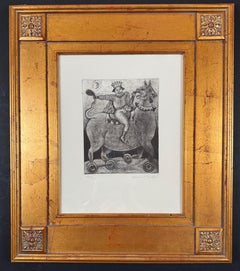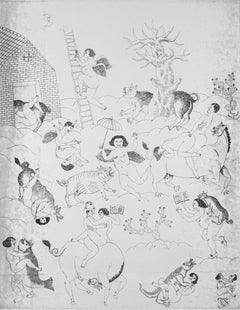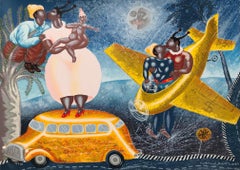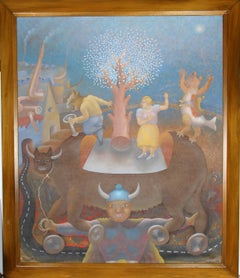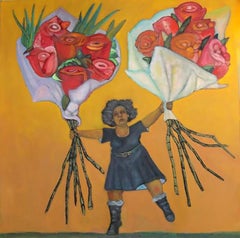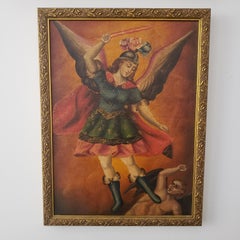Maximino Javier Art
to
2
1
1
Overall Width
to
Overall Height
to
3
1
1
2
2
1
3
1
4
3
3
1
1
1
1
1
1
1
2
2
1
1
1
4
8,816
2,808
1,655
1,313
2
4
Artist: Maximino Javier
untitled (horseman)
By Maximino Javier
Located in Palm Springs, CA
This whimsical and surreal etching by Mexican artist Maximino Javier, dated 1984, embodies his unique visual language that blends fantasy, folklore, and satire. Executed with intrica...
Category
1980s Contemporary Maximino Javier Art
Materials
Etching
El Jardin de las Delicias, by Maximino Javier
By Maximino Javier
Located in Palm Springs, CA
El Jardín de las Delicias by Maximino Javier was created in 1970. This date places it within a significant period of artistic exploration, reflecting the cultural and social themes p...
Category
1970s Surrealist Maximino Javier Art
Materials
Etching
Maximino Javier Mexican artist original hand signed silkscreen surrealism
By Maximino Javier
Located in Miami, FL
Maximino Javier (Mexico, 1948)
'Bajada de emergencia (serie Tamayo Total)', 2023
silkscreen on paper Canson 320 g.
20.3 x 28.2 in. (51.5 x 71.5 cm.)
Edition of 100
Unframed
ID: JAV-1...
Category
2010s Surrealist Maximino Javier Art
Materials
Cotton, Paper, Screen
Bull on Wheels (Dancing)
By Maximino Javier
Located in Long Island City, NY
An Oaxacan School oil painting by Maximino Javier from 1983. A whimsical scene of anthropomorphic figures. Framed in stained wood frame, signed in lower left corner.
Artist: Maximino Javier, Mexican (1948 - )
Title: Untitled - Bull on Wheels...
Category
1980s Folk Art Maximino Javier Art
Materials
Canvas, Oil
Price Upon Request
Related Items
Balance, Whimsical female with flowers, roses, bright golden sky
By Stephen Basso
Located in Brooklyn, NY
*ABOUT Stephen Basso
Stephen Basso's highly original pastels and oil paintings are romantic, yet thought provoking fantasies. His whimsical works are alive with boundless imagina...
Category
2010s Outsider Art Maximino Javier Art
Materials
Canvas, Oil
$3,200
H 40 in W 40 in D 2 in
San Miguel, St. Michael, School of Cusco, Peru, Framed early 1900's
Located in Houston, TX
This is painting is from the School of Cusco depicting St. Michael the Archangel defeating the devil in battle. It is oil on canvas and is in very goo...
Category
Early 20th Century Folk Art Maximino Javier Art
Materials
Canvas, Oil
$1,800
H 16 in W 12 in D 0.75 in
Salvador Dali Pencil Signed Nude on a Rhinoceros Horn
By Salvador Dalí
Located in San Francisco, CA
Salvador Dali: 1904-1989. One of the most famous artist of the 20th century. A master surrealist, whose auction prices are well into the millions. This image of a nude on a rhinocero...
Category
Mid-20th Century Surrealist Maximino Javier Art
Materials
Etching
African House
Located in Metairie, LA
Clementine Hunter, African House
This is an excellent example of Hunter’s work, featuring the iconic African House. Three figures are present in the work, a boy, a girl, and an elde...
Category
1960s Folk Art Maximino Javier Art
Materials
Canvas, Oil, Board, Pencil
Marc Chagall - Inspiration - Original Lithograph from "Chagall Lithographe" v. 2
By Marc Chagall
Located in Collonge Bellerive, Geneve, CH
Marc Chagall
Original Lithograph from Chagall Lithographe 1957-1962. VOLUME II.
1963
Dimensions: 32 x 24 cm
From the unsigned edition of 10000 copies without margins
Reference: Mourlot 398
Condition : Excellent
Marc Chagall (born in 1887)
Marc Chagall was born in Belarus in 1887 and developed an early interest in art. After studying painting, in 1907 he left Russia for Paris, where he lived in an artist colony on the city’s outskirts. Fusing his own personal, dreamlike imagery with hints of the fauvism and cubism popular in France at the time, Chagall created his most lasting work—including I and the Village (1911)—some of which would be featured in the Salon des Indépendants exhibitions. After returning to Vitebsk for a visit in 1914, the outbreak of WWI trapped Chagall in Russia. He returned to France in 1923 but was forced to flee the country and Nazi persecution during WWII. Finding asylum in the U.S., Chagall became involved in set and costume design before returning to France in 1948. In his later years, he experimented with new art forms and was commissioned to produce numerous large-scale works. Chagall died in St.-Paul-de-Vence in 1985.
The Village
Marc Chagall was born in a small Hassidic community on the outskirts of Vitebsk, Belarus, on July 7, 1887. His father was a fishmonger, and his mother ran a small sundries shop in the village. As a child, Chagall attended the Jewish elementary school, where he studied Hebrew and the Bible, before later attending the Russian public school. He began to learn the fundamentals of drawing during this time, but perhaps more importantly, he absorbed the world around him, storing away the imagery and themes that would feature largely in most of his later work.
At age 19 Chagall enrolled at a private, all-Jewish art school and began his formal education in painting, studying briefly with portrait artist Yehuda Pen. However, he left the school after several months, moving to St. Petersburg in 1907 to study at the Imperial Society for the Protection of Fine Arts. The following year, he enrolled at the Svanseva School, studying with set designer Léon Bakst, whose work had been featured in Sergei Diaghilev's Ballets Russes. This early experience would prove important to Chagall’s later career as well.
Despite this formal instruction, and the widespread popularity of realism in Russia at the time, Chagall was already establishing his own personal style, which featured a more dreamlike unreality and the people, places and imagery that were close to his heart. Some examples from this period are his Window Vitebsk (1908) and My Fianceé with Black Gloves (1909), which pictured Bella Rosenfeld, to whom he had recently become engaged.
The Beehive
Despite his romance with Bella, in 1911 an allowance from Russian parliament member and art patron Maxim Binaver enabled Chagall to move to Paris, France. After settling briefly in the Montparnasse neighborhood, Chagall moved further afield to an artist colony known as La Ruche (“The Beehive”), where he began to work side by side with abstract painters such as Amedeo Modigliani and Fernand Léger as well as the avant-garde poet Guillaume Apollinaire. At their urging, and under the influence of the wildly popular fauvism and cubism, Chagall lightened his palette and pushed his style ever further from reality. I and the Village (1911) and Homage to Apollinaire (1912) are among his early Parisian works, widely considered to be his most successful and representative period.
Though his work stood stylistically apart from his cubist contemporaries, from 1912 to 1914 Chagall exhibited several paintings at the annual Salon des Indépendants exhibition, where works by the likes of Juan Gris, Marcel Duchamp and Robert Delaunay were causing a stir in the Paris art world. Chagall’s popularity began to spread beyond La Ruche, and in May 1914 he traveled to Berlin to help organize his first solo exhibition, at Der Sturm Gallery. Chagall remained in the city until the highly acclaimed show opened that June. He then returned to Vitebsk, unaware of the fateful events to come.
War, Peace and Revolution
In August 1914 the outbreak of World War I precluded Chagall’s plans to return to Paris. The conflict did little to stem the flow of his creative output, however, instead merely giving him direct access to the childhood scenes so essential to his work, as seen in paintings such as Jew in Green (1914) and Over Vitebsk (1914). His paintings from this period also occasionally featured images of the war’s impact on the region, as with Wounded Soldier (1914) and Marching (1915). But despite the hardships of life during wartime, this would also prove to be a joyful period for Chagall. In July 1915 he married Bella, and she gave birth to a daughter, Ida, the following year. Their appearance in works such as Birthday (1915), Bella and Ida by the Window (1917) and several of his “Lovers” paintings give a glimpse of the island of domestic bliss that was Chagall’s amidst the chaos.
To avoid military service and stay with his new family, Chagall took a position as a clerk in the Ministry of War Economy in St. Petersburg. While there he began work on his autobiography and also immersed himself in the local art scene, befriending novelist Boris Pasternak, among others. He also exhibited his work in the city and soon gained considerable recognition. That notoriety would prove important in the aftermath of the 1917 Russian Revolution when he was appointed as the Commissar of Fine Arts in Vitebsk. In his new post, Chagall undertook various projects in the region, including the 1919 founding of the Academy of the Arts. Despite these endeavors, differences among his colleagues eventually disillusioned Chagall. In 1920 he relinquished his position and moved his family to Moscow, the post-revolution capital of Russia.
In Moscow, Chagall was soon commissioned to create sets and costumes for various productions at the Moscow State Yiddish Theater...
Category
1960s Surrealist Maximino Javier Art
Materials
Lithograph
$1,482
H 9.45 in W 12.6 in D 0.04 in
Alice In Wonderland: Hookah Smoking Caterpillar, Hand signed Etching, Erotica
By Knox Martin
Located in Union City, NJ
Alice In Wonderland:Hookah Smoking Caterpillar is an original hand made etching by the American abstract painter Knox Martin. Printed in black ink on archival printmaking paper, 100% acid free. Erotic fantastical interpretation of “Alice’s Adventures in Wonderland”, where Alice first meets the Catepillar while he is sitting on a mushroom smoking a hookah. He helps her by advising her to eat from the mushroom if she wants to change her size. Print size- 18" x 15", Image size - 8.25" x 6.75" Edition size - 50
About the artist-
Knox Martin (1923-2022) was an esteemed New York School painter.
Knox Martin was born in 1923 in Barranquilla, Colombia. He was the son of the aviator, painter, and poet William Knox Martin, the first man to fly over the Andes mountains.
After serving in World War II, Knox Martin attended the Art Students League of New York on the G.I. Bill from 1946-1950, where he studied with Harry Sternberg, Vaclav Vytlacil, Will Barnet, and Morris Kantor.
In 1954, Knox Martin's friend Franz Kline placed a painting of his in the Stable Gallery Annual.
Charles Egan of the renowned Charles Egan Gallery saw Knox Martin's painting at the Stable Gallery and asked Martin to show his work in a one-man show for the tenth anniversary of the Egan Gallery.
Since then, Knox Martin was a celebrated painter, sculptor and muralist. Knox Martin had an extensive exhibition record and his work is in museum, corporate and private collections worldwide. His two best-known murals in NYC are Venus and Woman with Bicycle...
Category
1970s Contemporary Maximino Javier Art
Materials
Etching
$340 Sale Price
28% Off
H 18 in W 15 in
"Omniverso" Omniverse - contemporary, surrealist, graphic, geometric sun print
By Pedro Friedeberg
Located in Ciudad de México, MX
The repetition of patterns and rhythm is present in almost every piece of Pedro´s work.
The hybrid topographies that Pedro Friedeberg´s unclassifiable practice recreates we must rec...
Category
21st Century and Contemporary Surrealist Maximino Javier Art
Materials
Digital
Large Scale Early 20th Century Oil on Canvas, The Agriculture and Livestock Fair
Located in Cotignac, FR
A large early 20th Century naive, folk art, oil on canvas view of a livestock fair by Tanim. The painting is signed bottom left.
A wonderful, humorous and playful view of animals an...
Category
Early 20th Century Folk Art Maximino Javier Art
Materials
Canvas, Oil
$2,845
H 39.38 in W 28.75 in D 0.79 in
The sun, from The Hippies
By Salvador Dalí
Located in Washington, DC
Artist: Salvador Dali
Title: The sun
Portfolio: The Hippies
Medium: Color etching on Arches
Date: 1969
Edition: 102/145
Frame Size: 31" x 26 1/2"
Sheet Size: 26" x 20"
Image Size: 15...
Category
1960s Surrealist Maximino Javier Art
Materials
Etching
The corridor of Katmandu, from The Hippies
By Salvador Dalí
Located in Washington, DC
Artist: Salvador Dali
Title: The corridor of Katmandu
Portfolio: The Hippies
Medium: Etching on Arches wove paper
Date: 1969
Edition: Unnumbered proof
Frame Size: 34 1/4" x 27 1/2"
S...
Category
1960s Surrealist Maximino Javier Art
Materials
Etching
Beauty of Southeast Asian Ethnical Cultures, Dubuffet-liked art brut style
By Yeanni Koo
Located in Kuala Lumpur, MY
CutieCow #1
Malaysian artist Yeanni Koo, inspired by folk art and children art, created childlike wonder style in her paintings. Koo’s painting evoke...
Category
21st Century and Contemporary Outsider Art Maximino Javier Art
Materials
Canvas, Oil
$600
H 18.9 in W 18.9 in
Salvador Dali - Corrida - Vintage Poster with Etching
By Salvador Dalí
Located in Collonge Bellerive, Geneve, CH
Salvador Dali - Corrida - Vintage Poster with Etching
Etching made behind a menu in Restautant Duran as a tribute dinner to Salvador Dali and his wife Ga...
Category
1960s Surrealist Maximino Javier Art
Materials
Etching
Maximino Javier art for sale on 1stDibs.
Find a wide variety of authentic Maximino Javier art available for sale on 1stDibs. If you’re browsing the collection of art to introduce a pop of color in a neutral corner of your living room or bedroom, you can find work that includes elements of blue and other colors. You can also browse by medium to find art by Maximino Javier in canvas, fabric, oil paint and more. Not every interior allows for large Maximino Javier art, so small editions measuring 40 inches across are available. Customers who are interested in this artist might also find the work of Jose Maria de Servin, Branko Bahunek, and Jaimendes. Maximino Javier art prices can differ depending upon medium, time period and other attributes. On 1stDibs, the price for these items starts at $125,000 and tops out at $125,000, while the average work can sell for $125,000.
